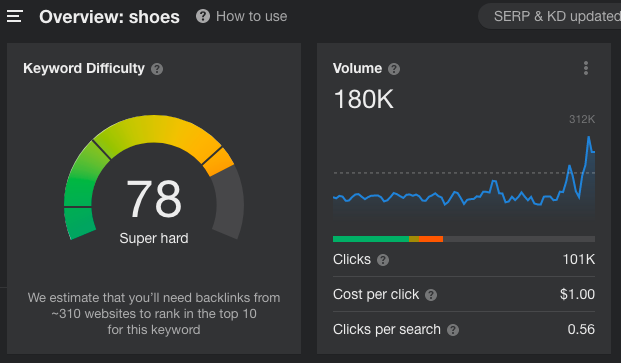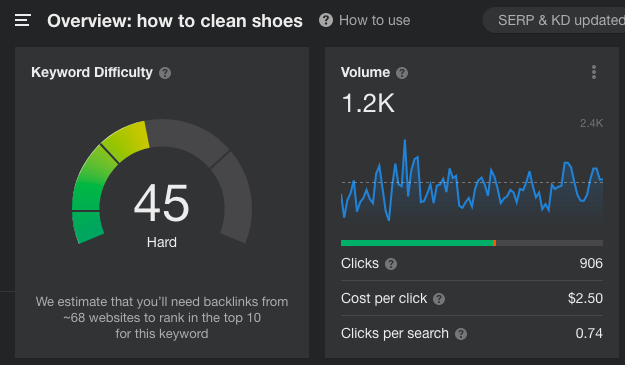Chances are you’ve already thought about how to improve SEO rankings. If you’re still not seeing the results you want or overall want to see more traffic, check out these 7 steps.
Following these steps can help your website appear more frequently on search engines and overall gain a bigger website presence.
Let’s get started.
Step 1: Optimize existing content
Before implementing new search engine optimization changes to increase your search ranking, it’s best to start with the existing content of the pages on your site.
Each day there are 100s if not 1000s of new content being published. Google search engines are able to tell which content is new and which has been sitting on the internet for a long time.
Your articles that are over 12 months old, are just not new anymore.
By updating your content with new images, new links, and new information you’ll essentially be publishing a new article according to Google, and can see a traffic boost.
Even if we break down the reasoning it becomes clear why to Google search engine rankings do this.
As new information continues to circulate online whether it’s for best business practices or new techniques, it’ll continue to be better than the old ways or old information.
Wouldn’t you want to get the most updated information when browning for answers?
To recap:
- Update articles that have been published past the 12-month marker.
- Update links, photos, and information
Step 2: Optimize content for snippets
Snippets on Google’s search results have become great ways to rank on Google. If you’re unfamiliar with these Google gives you a description of what you’re looking for directly on the 1st page.
These descriptions are also FAQs sometimes. This saves the user time by getting an answer directly without clicking through to a link.
Snippets are usually pulled from the top result pages and if you have your content formatted, there’s a chance you’ll end up in the right spot – this is key.
Your content needs to be set up in a way that Google will be able to scan and accurately pull data from. Using headings is going to help you the most here. Properly add the title tag heading for each blog post or article.
Chances are the CMS you’re using allows you to do this – without it, Google has no idea what you’re headings are. Other areas of snippet Google can pull data from is bulletin points, list, and questions.
To recap:
- properly add title tags for all content

Step 3: Find better keywords
Finding better keywords may seem like the obvious decision to improve your search ranking, but a lot of people don’t consider the keyword difficulty and ranking.
Chances are main target keywords for your brand are high volume and most likely high keyword difficulty. Would it be great to rank for these keywords? Yes, of course, but is it likely in a realistic frame, that answer is no.
You’re much better off focusing your keyword efforts on keywords that have a low keyword difficulty. These keywords typically have lower volume, but you’ll be able to rank better within these keywords to improve your SEO.
Here are some guidelines for finding lower keyword difficulty words.
Question keywords
First, type your keyword in Google search results and scroll down to the “people ask” section. It should give you 3 to 4 questions around the keyword phrase, you can even click on one of the questions and even more, questions will populate.
All of the questions popping up are from people searching for information about your keyword. Next, take any keyword software tool you’re using and do research on the questions that popped up.
You may find some target your audience better or have more volume than others. Regardless you’ll have a lower keyword difficulty than just using a main keyword.
Long tail keywords
These are keywords that are typically a few words long, rather than the 1-2 words of short-tail keywords.
Short-tail keywords will be more difficult to rank for. They will have high volume and high keyword difficulty scores making it nearly impossible to rank on Google for them.
Much like using questions, long tail keywords will have lower keyword difficulty scores that will help you rank better. It may have a lower volume, but being able to populate on the search page is a better trade-off for lost volume.
Let’s look at an example:
For a business owner selling shoes, it’s going to be hard to rank for shoes as shown on Ahrefs.com keyword research tool.

However, if we look at a question surrounding shoes, like “how to clean shoes”, we can tell this keyword would be much easier to rank for compared to above.

To recap:
- Find question keywords
- Find long tail keywords
Step 4: Use linking for stronger rankings
Backlinks are an essential part of any SEO strategy. By following every SEO tip in the book, it doesn’t necessarily mean you’ll rank on Google – but this is where backlinking comes in.
Backlinking is linking another web page within your own article. It builds trust within your page making Google more likely to position your page.
Backlinking is different from internal links because you’re linking outside of your website on other pages.
To help build your backlinking you can start guest posting. You’ll be able to contribute your content to other websites, in exchange for providing a link back to your website.
Another key way can be following trends. If your niche matches a trending news story or company you can reach out to a publisher to feature your content to add value to their readers and gain yourself a backlink.
*Quick tip check all links on the website for broken links – everything should function properly on your site.
To recap:
- Use linking for trust on Google
- Follow trends or offer guest posting
Step 5: Publish high-quality content
Creating content on the web needs to be high quality. The better the content is the more likely Google is to rank it in the top suggestions.
Before Google rankings were more about doing SEO practices and for the most part, it still is this way, however, quality content is now part of the ranking system to improve SEO.
Google’s last update highlights EAT which stands for expertise, authoritativeness, and trustworthiness.
EAT is evaluated by real-life people that help steer the algorithm so it knows what to look for.
Expertise – To determine the quality of the information piece posted. Is the author of the topic an expert? Do they have general expertise on the subject?
Authoritativeness – It’s the overall reputation in your industry. The rating system isn’t just looking at the article’s author here. They’re looking at the company as a whole.
Trustworthiness – Having trusted information on the content is key here. Does it have factual information, trustworthy sources or a secure connection? All of this can play into the trustworthiness of the site.
Although a good rating score doesn’t necessarily mean you’ll track on Google, we do know a badly rated EAT article won’t perform well. It’s essential to keep these practices in mind when creating each content piece.
To recap:
- Always produce quality content
- Follow eat for each content piece

Step 6: User-friendly
Your user interface matters. How the site loads, how easy it is to navigate or how users interact with your website all taken into account. A bad user interface won’t be picked up by Google. Your site needs to run smoothly and operate efficiently.
Another key objective with user-friendliness is being optimized for mobile devices. More people than ever before are using mobile for searching. Most CMS platforms allow you to optimize for mobile, so they shouldn’t be an issue to implement.
Google’s also takes into consideration your mobile friendliness to improve your SEO. They’re going to show the website that shows better on mobile.
To recap:
- Optimize user interface for efficiency
- Take on mobile
Want to improve your website design? Check out our article “10 Ecommerce Website Design Tips“.
Step 7: Track metrics and be patient
Implementing all the steps here will help you improve your search engine ranking for Google, but be patient. Making these changes today doesn’t mean Google will show your page first today. Let these changes take time before expecting results.
Tracking your metrics is a great way to see what’s working and what’s not working. (Google Analytics is a great way to track metrics). Monthly checks can be done to gain an overview of your SEO strategy.
Website traffic is going to be your biggest indicator of success here, more specifically organic traffic – this tells you people are coming from Google to your site.
SEO is always changing and no one quite knows when the changes happen or what is best for SEO. There’s always going to be new information that comes out that will help you improve your SEO ranking.
Tracking can help in knowing when changes have been made and then you can retest to see what’s working. SEO is a never-ending process.
To recap:
- Be patient
- Continually check metrics
- Always keep learning

